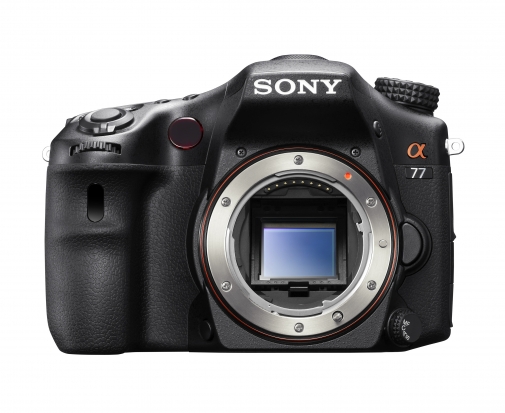
Sony's new Alpha SLT 77 uses ancient tech in a new way. Nifty stuff.
A pellicle mirror is a semi-translucent mirror used in a few very rare and far-between cameras - until recently, when Sony re-introduced the technology in a few of their compact system cameras. So why are Sony reaching into photography history to make new cameras?
Let's take a look at the technology...
The idea of a pellicle mirror is that it takes the place of a moveable SLR mirror. In traditional SLR cameras, the tech looks something like this:
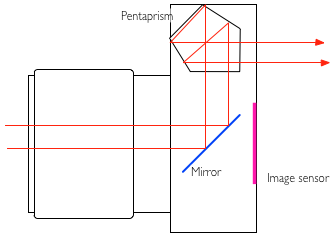
The lens focuses the image and flips it upside-down in the process. It then reflects off the mirror, into the pentaprism. The pentaprism flips the image rightside-up again, so you're looking at the world as you're used to seeing it.
When you are taking a photo, the mirror flips out of the way, so the light reaches the sensor, enabling you to take your photograph:
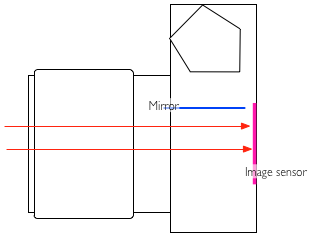
A pellicle mirror does things differently; it is, in fact, a semi-translucent mirror, which lets some light through to the imaging sensor, and some light through to whatever else needs to see the light: In Pellicle mirror SLR cameras, it sends part of the light into the pentaprism so you can view it through the viewfinder:
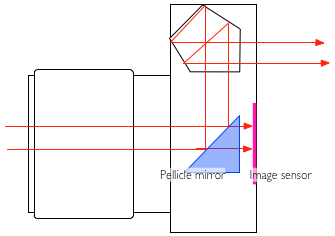
Why use a pellicle mirror?
The advantages of using a pellicle mirror are many: The viewfinder never goes dark, so you can see what happens all the time. There's no mirror slap - this is good for macro photography, where even the slightest shake of the camera can cause a blurred image - and it makes the camera significantly quieter as well.
Finally, back when pellicle mirrors were first introduced back in 1965, it was the only way to get high-speed photography done, enabling pictures to be taken at a faster continuous rate. Why? well, because the mirror does not have to go up and down for every image.
The EOS 1N RS (RS stands for Rapid Shooting), for example, can take 10 pictures every second
There are a few disadvantages to using a pellicle mirror - traditionally, pellicle mirrors caused about a 1/3 stop of light loss. (Some light has to go to the viewfinder). In addition, The mirror has to be kept perfectly clean, or else the light sensor and other electronics (as well as the image quality, obviously) will suffer, but cleaning a pellicle mirror is a bit of a specialised job.
The reason why a pellicle mirror has to be kept so much cleaner than a 'normal' mirror, is that a normal mirror isn't part of the optical path to the film or sensor: If you have a dirty mirror in your SLR, that's annoying when you're using your viewfinder, but it flips out of the way before a photo is taken, which means that it doesn't really matter. In addition, when you change lenses, the mirror offers a little bit of protection for the shutters whilst the innards are exposed. On a pellicle-mirror camera, what you see is what you get: It's the front-most element of the camera, and if it gets dirty, your images will degrade in quality.
Pellicle mirrors have been used in the Canon Pellix QL (1965), the Canon F-1 High Speed (a limited edition camera introduced for the 1972 Olympics), the Canon EOS RT (1989), and the Canon EOS 1N RS (1994). On the Nikon side, pellicle mirrors were used in the Nikon F2 HS and the Nikon F3 HS; the latter was introduced for the 1998 Nagano Olympics.
Pellicle mirrors in the digital age
Sony have re-embraced the technology in a couple of new launches, including the top-of-the-line Sony SLT Alpha 77, and the Sony SLT Alpha 65:
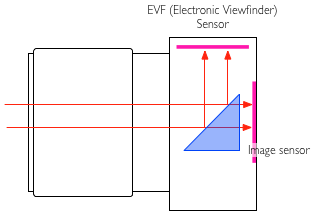
The advantages of using a pellicle mirror in this case are many; Using the image sensor for the EVF causes it to slowly heat up, which degrades image quality through the addition of extra noise. By using a dedicated (presumably lower-power-consumption) secondary sensor for the image preview, you can get better battery life, and higher quality photographs to boot.
